|
Unless you really know your Japanese cinema, there's a good
chance you'll have never heard of Hanzo the Razor,
the lead character of three films from 1972 to 1974, all
starring and co-produced by Katsu Shintaro. They were certainly
new to me. Made during a period of changing public tastes,
they present something of a dilemma for a modern audience. Stylish and highly engaging, they are also very much products
of their place and time, and include an element that...
well, let me tell you a little about the character and setup
and you'll soon understand.
Itami Hanzo
is a law officer in Edo period Japan. At the start
of the first film he refuses to sign a blood oath required
of all policeman because, he tells his superiors to their
faces, the force is riddled with corruption. He will do
his job and do it well, but he will do so without lending
his approval to the bribe-taking on which the department
appears to thrive. This enrages his immediate boss, Onishi Magobei, but Hanzo's not too impressed with him either and
there's not much Onishi is ready to do about it. After all,
Hanzo is not just a good cop, he's the best the department's
got.
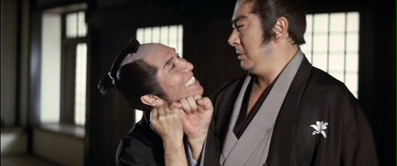
OK,
so far so good. Despite being set in Edo Japan, this
is familiar existentialist cop stuff, Dirty Harry for the
samurai age if you will. Well, not quite. Once he's back at home we find Hanzo
kneeling on a painful looking base of triangular wooden
blocks as his two servants pile stone stabs onto his legs,
crushing his limbs and drawing blood.
They protest at being ordered to hurt him so, but he saved both of them from jail and they are thus in everlasting obedience to
their master. This is not some masochistic or religious
self-punishment, but an attempt by Hanzo to get inside the
criminal mind, to understand the pain of the torture some
have suffered before turning to a life of crime. His body
shows the scars of previous violence he has endured in the
name of such enlightenment. Hanzo is a man whose
dedication to his job borders on the obsessive, some might
say the psychotic.
But
this is nothing. Hanzo has another daily exercise, and this
is definitely one you won't have seen Dirty Harry indulging
in. Are you ready for this? After a long soak in a hot bath,
he washes his penis with steaming hot water, places it on
a wooden block prepared especially for the purpose and repeatedly
beats it with a large stick. He's been doing this so long
that the wood now bears the imprint of his erect member,
which he then inserts into a casket of rice and effectively
has sex with it. As a result he has a permanent and sizeable
hard-on.
Still
with me? Well try this for size. Hanzo is, as you'd expect,
a skilled fighter who always gets his man, one who will smash in the nose of a suspect and proclaim him dead in order
to haul him off and continue his cross-examination in private.
For women, though, he has a very particular method of interrogation,
and this is where the difficulties will set in for a modern
and hopefully enlightened western audience. To secure the co-operation
of his female prisoners, Hanzo puts his carefully prepared
and oversized penis to use and rapes them. His favourite
method, which he describes as his 'special torture', involves
them being hauled aloft in a large net and lowered by his
servants onto his member, lifted repeatedly up and down
and then spun round in a circle. And they tell him what
he wants to know not because of the pain or the indignity
or the horror of what is happening, but because they don't
want him to stop.
You
see the problem.
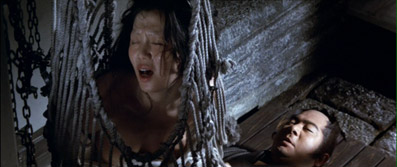
Now
I'd written all of the above before I read the notes by
respected Asian cinema writer Tom Mes, who acknowledges
the issue but suggests that if you're in any way outraged
by this concept then you probably haven't seen the film,
just read a plot summary, and that you can't take it too
seriously anyway because it's intended as parody. To a degree
he's right. Hanzo's keep-it-hard exercises alone seem to indicate that we're in comic book territory (the series was based on
a Manga by Kazuo Koike) and there is a deliberate absurdity
to the whole premise that is acknowledged in the handling
of these sequences, with one glimpse of Hanzo's todger enough
to make any woman go wide-eyed and slack-jawed in disbelief.
But Mes is also, like a few other reviewers I've encountered,
a little too quick to gloss over what will definitely cause
offence to some, even if it is light hearted in tone. The
"it's only a movie" response is both common and
valid, but every such reaction to Hanzo's activities I've
read has been from a male viewer and I'm always curious
to know just how confident they'd be defending these scenes
to a genuine rape victim.
It's
important, of course, to remember just when and where the
films were made. Mes draws parallels with 60s western movie
icon James Bond, a super-cool secret agent whose sex appeal was
such that women would drop their knickers at the raise of
an eyebrow. Hanzo also shares a few traits with early Clint
Eastwood characters (whose Man With No Name was itself drawn from the
Japanese jidaigeki genre), not least the anti-hero at the
centre of High Plains Drifter (1973), whose
first act on riding into the frontier town of Lago is to
drag a mouthy woman into a barn and rape her, a scene made
all the more uncomfortable today by the pacifying effect
it ultimately has. This is the male avenger at his most
primitive – men are shot or stabbed, women are raped, but
penetration of some sort key to the punishment of both.
More
significant is the cultural element. This is Japanese cinema
from the early 1970s, when the straight jidaigeki (historical)
and specifically chambara (swordplay) films were fading in popularity and pinku eiga (pink films, a uniquely
Japanese form of softcore porn) were on the rise. Japanese
society is a historically patriarchal one and sex and violence
would happily go hand-in-hand in art and entertainment,
to a degree that can seem alarming to a modern western audience.
Hentai manga in particular has its darker corners, not least
Keiko Aisaki's Rapeman, a short-lived comic book
series from the late 1980s that delivered on its title and
gave birth to seven live action features and a full length
anime, none of which have – surprise surprise – turned up
on UK DVD. It's a sign of the changing face of Japanese
cinema that in Miike Takashi's 1995 Shinjuku Triad
Society, rape is still employed as a tool of torture
and punishment, but it's the men who can expect to be on
the receiving end.
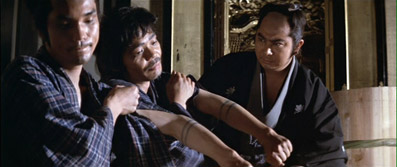
But
if you can tolerate or perhaps turns a blind eye to Hanzo's
razor and the use to which it is put, this is a trilogy most definitely
worthy of your attention. These are jidaigeki films invigorated
by energetic fight choreography and Katsu's practiced sword
hand, and are infused with a late 60s distrust of the establishment. In Hanzo's world, just about everyone in a position of
power is corrupt to the core – even his own boss, Magobei
Onishi, has picked up the nickname 'snake' for his slippery
dealings. The only trustworthy recurring characters are
Hanzo's servants, colourfully named Devil Fire and Viper,
whose reluctant obedience is ensured by irregular reminders
of their criminal past and where they'd be if not in Hazo's
protective employ – by the second film they only have to
hear the words "Show me your arms!", limbs which bear the tattoos of their former criminal status, to groan
and capitulate. There's even a perverse element of class
war at work – Hanzo readily works his 'special torture'
on the wives and mistresses of samurai or high officials,
but is willing to defend to the death the honour of a servant
girl kidnapped and threatened with gang rape.
The
parallels with James Bond extend to Hanzo's impressive armoury
and gadgetry, his house a collection of concealed weapons
and booby-traps for the unwary. Think you can take Hanzo
because he's naked in a hot tub? Think again, as one tap
on the wall will place a range of deadly implements within
arm's reach. Fancy your chances because you've got him trapped
in a narrow corridor? Better watch your step, as that floor
might just open and plunge you onto lethal pin cushion of
spears. And if you think you can best him in a sword fight
then watch out – Hanzo's weapon of choice is a pair of daggers
linked by a chain that can block and even incapacitate swords
and their users, a device that would usually be more at home in Chinese martial
arts movies than Japanese jidaigeki.
Actor
Katsu Shintaro made his name as the blind swordsman
Zatoichi in a long-running an hugely popular series of films
for the Daiei Motion Picture Company, but following Daiei's
bankruptcy in 1971, production of the films moved to Toho.
By then their popularity and originality was starting to
wane – Zatoichi at Large, the first Toho
film in the series was the twenty-third overall, and three films later Katsu
played Zatoichi for the last time. The actor was clearly
keen to establish a new on-screen identity, one with Zatoichi's
fighting skills but a little something extra, and no doubt
Toho, aware of the changing times and the extraordinary
popularity of the pinku eiga films, recognised that this
could be potentially lucrative for them. It's
not hard to see why the series never made it past three
films, though. As Tom Mes notes, Hanzo's method of interrogation
and 'special torture' remained undeveloped constants of
all three films, and by the third they were already starting
to feel like obligatory components.

The
sexual politics may be severely dated and even peculiar,
but in all other respects the Hanzo the Razor films are a class act. Their blend of old-school swordplay,
James Bond gimickery, twisted eroticism and political allegory
is as appealing as it is unique, and technically they are
sharp as a samurai sword – these are really well
made films. It
may mean shutting down your sensitivity gland for a few
scenes, but for devotees of Japanese jidaigeki cinema, or
those with a taste for the unusual or perverse, the Hanzo
the Razor films really are a must.
As
a final point of interest, I watched all three films with
a middle aged female Japanese friend and she enjoyed them
a great deal and was not in any way offended or surprised by Hanzo
and his singular methods of interrogation. During one such
scene involving samurai's wife, I questioned her directly
on it. "Doesn't this bother you a bit?" I asked.
"What you must remember," she told me as if I'd
been there at the time, "is
that when this film came out, Japanese audiences liked to
see the wife of a samurai being raped. It was a man's dream."
This did nothing to dilute my considerable discomfort.
| Hanzo
the Razor: Sword of Justice / Goyôkiba |
|
The
film that introduced our anti-hero is obviously the one
with the most surprises for newcomers, from Hanzo's self-flagellation
to his troubling interrogation techniques. I came to this
with no knowledge of the content and was left genuinely
slack-jawed. My Japanese companion, as I said, was amused
but not in any way shocked. Your own reaction will depend
on your viewing experience, expectations and personal politics.
In the very first scene, Hanzo is painted as a renegade cop
who holds his superiors in contempt, especially when he
discovers that one of them – the aforementioned Snake Magobei
– is in bed with the same woman as notorious master criminal
Killer Kanbei. They don't know the woman's name, but identify
her by her lack of pubic hair (don't ask how). Hanzo pays
her a visit and spends a long time on the interrogation,
and the information he retrieves suggests a bigger plot that
may involve corruption at the highest level.
Daffy
though some of the film is, the comedy is actually rather
stone-faced here, save for a brief interlude involving a
group of guards at the North Magistrate's Office played
by the Manzai comedy group The Chambara Trio. The drama,
though, has enough twists and intrigue and sexually peculiar
interludes to launch the series with the right sort of,
erm, bang. The western 60s influence is most evident in
this film, from the sometimes madly anachronistic soundtrack
that could almost have wandered in from a Shaft
sequel, to the fight scene shot from unexpected (and not
always the clearest) angles.
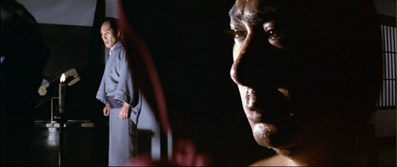
It's
involving and entertaining stuff, a samurai detective story
infused with pinku eiga eroticism and a strand of dark
humour. The production values are high, the performances
enjoyable and the stylish final shot looks forward to the
sequels that you'll be glad you have to hand.
| Hanzo the Razor: The Snare
/ Goyôkiba: Kamisori Hanzô
jigoku zeme |
|
The
best film in the trilogy starts and concludes on the same
bridge, the first encounter reminding us that Hanzo can
take on a small army of swordsmen with just his chain-linked
daggers and not get a scratch. That the warriors are the
personal guard of government treasurer Lord Okubo cuts no
ice with this particular law enforcement officer – they're in his way
so they have to die. Already dead is Omachi Surugaya, a merchant's
daughter and the victim of a botched abortion. I'll leave
it to you to guess how that diagnosis is made. This leads
Hanzo to a female-run shrine that specialises in such operations,
and a convent priestess who sells the virtues of her young
female students to the highest bidder from a rabble of well-connected
and corrupt noblemen. Plenty for Hanzo to do here, then.
There's
more nudity this time and more overt eroticism, not least
in the rituals and practices of the exotic abortionist,
who turns a medical act into a lesbian come-on and whose
self-confident frankness with Hanzo is guaranteed to provide
the audience a small frisson of delight. Hanzo gets to hide
in the closet of a well-to-do lady whom he then has his
way with, and a bald priestess is kidnapped, tied up, tortured
and then tortured again in that special way only Hanzo can
administer, a sequence that should have the nunsploitation
fans hugging themselves with glee.
Viper
and Devil Fire are elevated to comedy foils, an energetically
hapless double-act that nicely counterbalances Hanzo's unwavering
stern and impatient righteousness. Kazuo Miyagawa's cinematography
is consistently excellent and the fights are particularly
well choreographed to camera, from the close-quarters encounter
in Hanzo's booby-trapped house to the climactic battle with
Shobei Hamajima and his gang, which builds to a smartly
handled stand-off and a satisfying, corruption-busting conclusion.
Hanzo even gets a traditional one-on-one final sword fight
with a warrior who needs to test his skills against his
chosen nemesis and to stride off at the end in brusque,
Yojimbo style.
A
genuinely compelling and well-made blend of investigative
drama, oddball eroticism and jidaigeki action, whose tightly
constructed plot, engaging performances and off-the-wall
character detail make it the most dramatically and cinematically
satisfying of the three films.
Hanzo the Razor: Who's Got the Gold? /
Goyôkiba: Oni
no Hanzô yawahada koban |
|
The
last film in the series kicks off in style with Devil Fire
and Viper frightened off from their night-time fishing trip
by a ghost (handled in atmospherically kaidan style),
something Hanzo quickly exposes as fakery. A quick dip beneath
the water uncovers a bamboo pole crammed with gold coins.
Hey, we're right next to the shogunate treasury. What d'you
think could be going on here?
The
third Hanzo story is particularly aware of the comic potential
of Hanzo's unique talent and training methods – the image
of Devil Fire and Viper nervously relating their supernatural
experience to Hanzo as he beats his member with a stick
is genuinely funny, topped off by Hanzo's proclamation that
he'd rather like to make love to a ghost, just once. He
gets his chance, in a way, when he employs his 'special
torture' on the ghost's female impostor and she's assassinated
just before she talks ("She couldn't have picked a
better moment,�" groans her interrogator).
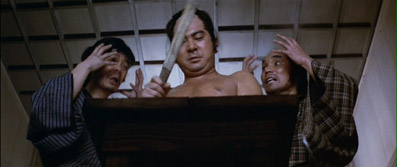
A
deputation of disgruntled shogunate samurai guards pop in
for a fight, led by Chozaburo Kato, husband of the unfortunate
girl. Inevitably they lose, and Hanzo once again gets political,
campaigning for the rights of the underpaid samurai he's
just killed and hiding a rebel doctor he has been forced
to arrest to allow the man time to build a canon, an instrument
that will wake the powerful and corrupt Elder
Hotta up to the importance of adopting western technology.
Snake Magobei is up to his old tricks, accepting a reward
refused by Hanzo and landing himself in Hanzo's pocket as
a result. By now Magobei has graduated from frustrated official
to excitable clown, something actor Ko Nishimura grabs with both hands and runs with (his frustration at Hanzo's insolence before
Elder Hotta is a comical hoot).
The
expected elements are all there, but a nice surprise arrives
in the shape of Heisuki, an old friend of Hanzo's who is capable
of the rare trick of putting a smile on the warrior's face
and getting him to relax with a few drinks. He's nonetheless
doomed from the moment we meet him – he has a family heirloom,
a Nagato Aeo spear, that Hotta covets and expresses his intention to own,
and his purpose in the narrative is clearly to die and spur
Hanzo into furious action. Hanzo once again has his way
with a lady of social standing, but in a scene whose striking
cinematography and editing stand it apart from any we've
seen before. He even drops in on an orgy, not to participate
but to brand the women involved and secure their later cooperation.
It's
another full blooded and enjoyable tale with a literally
explosive climax and an inevitable one-on-one battle between
Hanzo with Heisuki's murderer. The ending leaves the way
open for more, but they never appeared. It doesn't really matter – Who's Got
the Gold? is a fine film, but the decision to quit
at three before the formula began to stale was probably
a wise one.
Framed
2.35:1 and anamorphically enhanced, these restored and remastered
Toho licensed transfers are simply gorgeous – the colours
are rich but not over-saturated, the detail excellent and
the contrast and black levels close to perfect. For films
first released in the early 1970s, the picture quality here is
little short of miraculous.
The
original mono soundtrack has been left unmolested and unremixed.
Its age is betrayed by a restricted dynamic range and a
slight background hiss, but it's otherwise clean of noise
and damage and sounds about right for a film of this period.
Although
packaged together in a single box set, the individual keep
cases are worth a mention for their wonderful covers, which
feature unblemished reproductions of the original Japanese
posters.
Each
disc has the original trailer for the film in question and all are in sparkling shape.
There is also a booklet for each
film with detailed notes by Tom Mes, though not always specific
to the films.
Despite
my ethical discomfort with Hanzo's methods, I have to admit
to thoroughly enjoying the Hanzo the Razor trilogy, their polished and imaginative blend of the traditional
with the perverse making for a genuinely unique viewing
experience. But my opening warning remains valid – these
are not films for everyone and their archaic sexual politics
are guaranteed to cause problems for some viewers, something
the BBFC has acknowledged by slapping an 18 certificate
on all three of them. But there's so much that is good here
and the transfers so impressive that this box set just has
to come recommended, especially for fans of Japanese jidaigeki
or pinku eiga. Just be careful who you sit down to watch
them with.
|